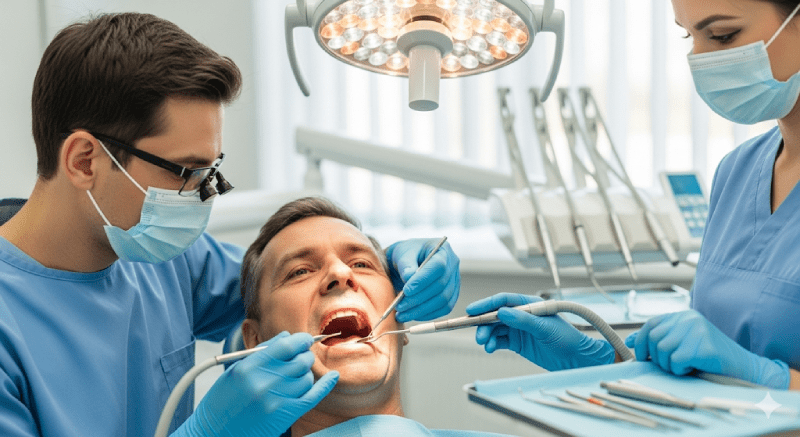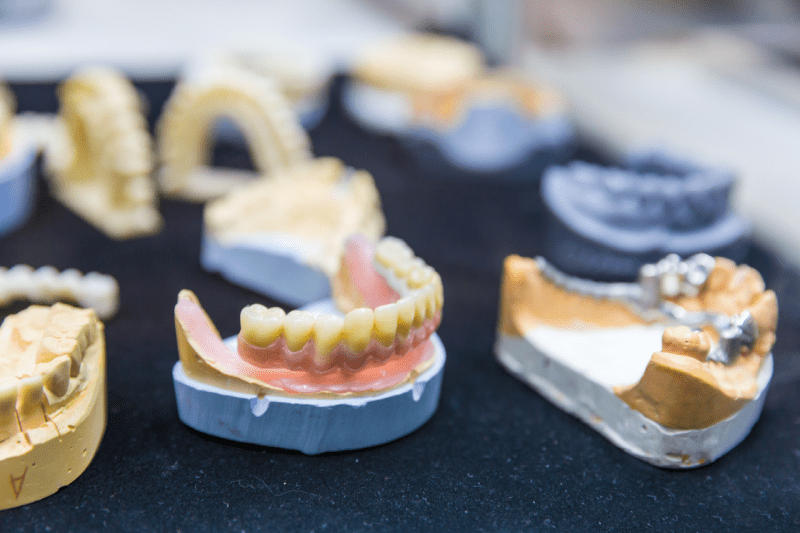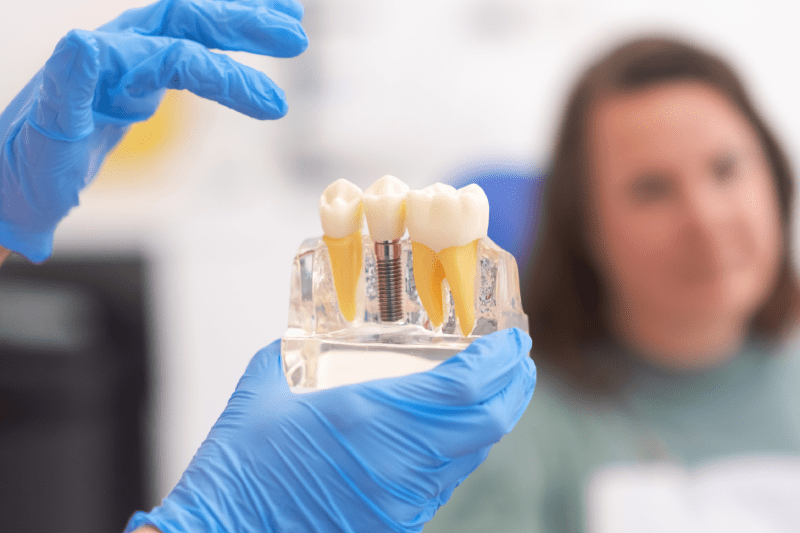Dental Implants: A Comprehensive Guide
What is a Dental Implant?
A dental implant is an artificial tooth root made from titanium or a similar biocompatible material, used to replace missing teeth. This small screw-like structure is surgically placed into the jawbone, and a prosthesis (crown, bridge, or denture) is attached on top of it, providing the appearance and function of a natural tooth. The excellent compatibility of titanium with the body allows the implant to fuse with the jawbone (osseointegration), which is vital for the success of the treatment. Implants not only address aesthetic concerns but also restore chewing function, aiding in digestion and contributing to the preservation of the facial structure.
When are Dental Implants Needed?
Dental implants are an ideal solution for individuals who have lost one or more teeth. Tooth loss can occur due to trauma, decay, periodontitis (gum disease), or genetic reasons. Implants protect healthy tooth tissue because, unlike traditional bridges, they do not require the adjacent teeth to be cut down. They also stimulate the jawbone, which tends to resorb (melt away) in the absence of teeth, thus preventing bone loss. Implant treatment is also frequently preferred to address functional problems such as difficulty in speaking and chewing caused by tooth loss.
Structural Components of an Implant
A dental implant system consists of three main components:
- Implant Body (Screw): This is the main part that is placed in the jawbone and acts as the root. It is typically made of titanium.
- Abutment (Connector): This part acts as a bridge between the implant body and the prosthesis (crown). It is attached to the implant after the jawbone has healed.
- Prosthesis (Crown): This is the artificial tooth cap that looks like a natural tooth and is placed on the abutment. It is produced from aesthetic materials such as porcelain or zirconia.
With the combination of these three components, both the root and the visible part of the missing tooth are completely restored.
Types of Dental Implants
Dental implants are classified according to their placement method:
- Endosteal (In-Bone) Implants: This is the most common type of implant. It has a screw or blade-like structure and is placed directly into the jawbone. This type is suitable for most patients and has a high success rate.
- Subperiosteal (On-Bone) Implants: This is a metal framework placed on top of the jawbone, under the gum tissue. It is an alternative for patients with very insufficient bone structure who cannot undergo bone grafting. It is less commonly used today.
- Intramucosal Implants: These are small, stud-like implants placed in the gum tissue, under the denture. They are generally used to increase the retention of removable dentures.
Ideal Candidates for Implant Treatment
Ideal candidates for implant treatment are those who have:
- Sufficient Jawbone Volume and Density: Adequate bone structure is essential for the implant to be placed stably.
- Good General Health: Individuals without uncontrolled chronic illnesses such as diabetes, heart disease, or immune system disorders.
- Good Oral Hygiene: Regular and good oral care is crucial for successful healing and a long-lasting implant.
- Smoking Habits: Excessive smoking can negatively affect the healing process and increase the risk of implant failure. Ideally, one should not smoke.
- Age: Individuals who have completed jawbone development (generally over 18 years of age) are suitable.

Pre-Implant Preparation Process
Implant treatment requires a comprehensive pre-preparation. This process is one of the most important steps in determining the success of the treatment:
- Initial Examination and Evaluation: The dentist examines the patient’s oral health, gum, and bone structure.
- Panoramic X-ray and Tomography (CT): A three-dimensional image of the jawbone is taken to examine the bone volume and the location of nerves and sinus cavities in detail. This allows for the determination of the most suitable position for the implant.
- Treatment Planning: Based on the data obtained, the dentist creates a personalized treatment plan for the patient. This plan includes the number of implants, type, surgical stages, and treatment duration.
What is Bone Grafting and Why is it Needed?
Bone grafting is a procedure performed when the jawbone is insufficient for implant placement. When a tooth has been missing for a long time, the bone tissue begins to melt away (resorption). It is not possible for an implant to stand firm without sufficient bone support. In the bone grafting procedure, bone material from the patient’s own body (autograft), a human tissue bank (allograft), animal sources (xenograft), or synthetic materials (alloplast) is used to add volume to the jawbone. After this procedure, the bone is expected to heal and new tissue to form before the implant can be placed.
Sinus Lifting Procedure
In the upper jaw, especially in the molar region, bone deficiency is often seen. The sinus cavities located in this area can cause a decrease in bone volume. The sinus lifting procedure is the gentle upward pushing of the sinus membrane, and the resulting space is filled with bone graft material. This provides sufficient bone height for implant placement. The procedure can be done simultaneously with the implant or as a separate session.
Implant Surgery Stages
Implant placement surgery is generally performed under local anesthesia and is painless:
- Anesthesia: The patient’s mouth is numbed, ensuring no pain is felt during the procedure.
- Incision: A small incision is made in the gum tissue to access the jawbone.
- Preparation: A special drill is used to prepare the socket in the jawbone where the implant will be placed.
- Placement: The titanium implant is carefully screwed into this socket.
- Suturing: The gum tissue is closed and stitched. The procedure usually takes 30-60 minutes for a single implant.
Healing Process and Osseointegration
After implant surgery, the most critical stage is osseointegration. During this process, the surface of the implant and the jawbone cells biologically fuse, allowing the implant to be completely integrated into the bone. The healing process varies depending on the patient’s general health, the quality of the jawbone, and the area where the implant is placed.
- Lower Jaw: Generally 2-3 months.
- Upper Jaw: Generally 3-6 months.
During this process, the patient must be very careful with oral hygiene and avoid applying pressure to the implant.
Second Stage Operation
After osseointegration is complete, a second operation may be required in some cases. This operation involves removing the healing cap that covers the implant under the gum and placing the abutment in its place. This minor operation usually takes a few minutes and is performed under local anesthesia. This procedure is not necessary for single-stage implant systems, as the head of the implant remains exposed during the operation.
Abutment and Crown Preparation
After the second stage operation, or while the healing cap is in place with single-stage implants, preparations for the prosthesis begin:
- Taking Impressions: The dentist takes precise impressions of the implant and surrounding teeth. These impressions are used to prepare the crown perfectly in the laboratory.
- Crown Design: Using digital technology (CAD/CAM) or traditional methods, a crown that is most suitable for the patient’s tooth structure, color, and shape is designed.
- Crown Production: The designed crown is produced from materials such as porcelain, zirconia, or metal-supported porcelain. Zirconia is one of the most durable materials and is the closest in appearance to a natural tooth.
Crown Placement and Final Checks
The prepared crown is permanently cemented or screwed onto the abutment. At this stage, the dentist checks for:
- Aesthetic Harmony: The color and shape harmony of the crown with the natural teeth.
- Functional Harmony: The patient’s comfort and bite alignment during chewing and speaking.
- Cleaning Possibility: Whether there are necessary spaces for the patient to clean the prosthesis easily.
After all checks are completed, the treatment is finished.
All-on-4 / All-on-6 Implant Techniques
All-on-4 and All-on-6 are special implant techniques developed for patients who have lost all their teeth. In these methods, a fixed full-arch prosthesis (bridge) is placed on 4 or 6 implants strategically positioned in the jaw.
- Advantages:
- Provides cost and time benefits as fewer implants are used.
- Minimizes the need for bone grafting.
- A fixed prosthesis can be obtained in a short time after the surgery.

Immediate Loading Implants
This is a method where a temporary crown or prosthesis is placed on the implant on the same day or a few days after it is placed, without waiting for the normal healing process. This is an attractive option, especially for patients with single-tooth loss or aesthetic concerns in the front teeth.
- Requirements: For this technique to be applied, the patient must have sufficient bone density and the implant must show very high initial stability within the bone. It is not a suitable method for every patient.
Advantages of Implant Treatment
- Natural Appearance and Feel: Implants are aesthetically indistinguishable from natural teeth and provide a comfortable feel to the user.
- Functional Improvement: Chewing and speaking functions are fully restored.
- Bone Preservation: It stops or slows down the jawbone resorption that occurs after tooth loss.
- No Damage to Adjacent Teeth: Unlike traditional bridges, there is no need to cut down healthy adjacent teeth.
- Longevity: With proper care and regular check-ups, an implant can last a lifetime.
Disadvantages and Risks of Implant Treatment
- High Cost: Implant treatment is more expensive than other prosthetic methods.
- Surgical Procedure: Since the treatment requires a surgical operation, it carries risks such as infection, bleeding, or nerve damage. These risks are minimized by a specialist in the field.
- Long Treatment Duration: Due to the osseointegration process, the treatment can last for several months.
- Risk of Failure: Although a very low probability, there is a risk that the implant may not fuse with the bone (osseointegration failure).
Dental Implant Care and Hygiene
Regular and correct care is very important to extend the life of implants:
- Brushing: The teeth and the area around the implant should be brushed at least twice a day with a soft-bristled toothbrush and fluoride toothpaste.
- Floss and Interdental Brushes: Special implant floss or interdental brushes should be used to clean the spaces between the implant and adjacent teeth.
- Mouthwash: The use of an alcohol-free, antibacterial mouthwash can help control bacterial plaque.
- Regular Dental Check-ups: Dental check-ups should be done at least twice a year to evaluate the condition of the implant and overall oral health.
Implant Lifespan and Success Rates
The success rate of dental implants is quite high, generally over 95%. With proper care, an implant can last a lifetime. However, the crown or prosthesis on the implant may need to be replaced after 10-15 years due to wear and tear. Factors affecting the implant’s lifespan include the patient’s oral hygiene, smoking habits, general health status, and the quality of the implant.
Factors Affecting Implant Prices
Dental implant prices can vary greatly depending on many variables. The main factors determining the price are:
- Implant Brand Used: There are hundreds of different implant brands worldwide. Premium brands produced by countries like Switzerland, Germany, and America are generally more expensive but can offer higher success rates in the long run. Brands from countries like Korea or China are more economical.
- Dentist’s Experience and Clinic Location: The prices of a specialist and experienced surgeon may be higher than those of a less experienced dentist. Also, clinics located in large cities or central locations generally have a higher pricing policy.
- Additional Necessary Procedures: If there is insufficient bone volume for implant placement, additional surgical procedures such as bone grafting and sinus lifting may be required. These additional procedures significantly increase the total cost.
- Prosthesis Type and Material: The material of the crown to be placed on the implant (porcelain, zirconia, metal-supported porcelain) and its type (single crown, bridge, removable denture) are important factors affecting the price.
- Exchange Rate: Since implant materials are usually imported, fluctuations in exchange rates directly affect prices.
Dental Implant Price Range and Examples
The price of a dental implant is not a single fixed figure; it varies widely depending on regional factors, the dentist’s experience, and the material used. While it is not possible to give a precise price, the pricing is generally a package deal of “implant screw + surgical procedure + abutment + crown.”
- Lowest Prices: These are generally for less-known or domestic implant brands, in simpler cases for a single tooth, and in lower-cost clinics. These prices can sometimes be initial prices that do not include additional procedures (x-rays, examination, etc.).
- Mid-Range Prices: These are prices for mid-range clinics that use globally accepted, reliable brands. Most patients prefer the services in this range.
- High Prices (Premium Segment): These are prices in clinics that use advanced technology, employ surgeons with international reputations, and use premium brands. Prices in this segment can be higher, especially for comprehensive and complex cases like All-on-4/6.
Important Note: It is crucial not to evaluate pricing by focusing only on the implant itself. Requesting a package price that includes all elements such as treatment planning, surgical procedure, abutment, and prosthesis will prevent you from encountering surprises later. Getting price quotes from multiple clinics will help you in your decision-making process.
Implant Brands and Quality Differences
Implant brands differ in terms of quality, R&D investments, and market share.
- Premium Brands: Brands like Nobel Biocare, Straumann, and Astra Tech are supported by years of scientific research and clinical studies. These brands promise high success rates and longevity.
- Mid-Range Brands: These cover a wide range and are more affordable than premium brands.
- Economical Brands: These are generally newer brands and are supported by less clinical data.
The choice of brand has a significant impact on the success and longevity of the implant. It is important to ask your dentist for information about the brand of implant that will be used in the treatment and why they prefer that brand.
Reversible Implants and Correction Procedures
The term “reversible implant” does not refer to a type of implant but rather the process of removing a misplaced or failed implant and preparing the area for re-treatment.
- Causes of Failure: Factors such as smoking, poor oral hygiene, uncontrolled diabetes, and improper angle of implant placement can lead to failure.
- Correction Procedure: The failed implant is surgically removed. The area is then waited to heal and for new bone tissue to form. If necessary, a bone graft is applied. Once healing is complete, a new implant can be placed in the area. This process can be longer and more complex than the initial treatment.
Dental Implants and Insurance Coverage
Dental implant treatment is generally not covered by insurance in many countries and insurance policies, as it is classified as a “cosmetic” or “elective” procedure. However, some private health insurance or dental insurance policies may cover a portion of the implant treatment.
- Policy Check: Before starting treatment, it is important to contact your insurance company to find out if your policy covers implant treatment or what portion of the cost will be reimbursed.
Frequently Asked Questions (FAQ)
- Is the implant procedure painful?
- No pain is felt during the procedure as local anesthesia is used. Afterwards, there may be slight pain or swelling, but it can be easily controlled with painkillers.
- How long does it take for implants to be completed?
- The treatment process can take from 3 to 9 months, depending on the complexity of the case.
- Will my body reject the implant?
- Since titanium is a biocompatible material, there is no such thing as the body rejecting the implant. However, failed osseointegration can occur.
- Can implants be done for every tooth loss?
- It is suitable for most cases, but prerequisites such as sufficient bone volume, good general health, and oral hygiene are required.
I hope this comprehensive guide has answered most of your questions about dental implants. Remember, the best thing to do is to consult a dentist for the most accurate information and to have a personalized treatment plan created for you.



